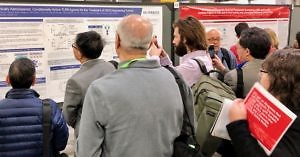How F-star are optimising bispecific antibodies for cancer treatment
Mononclonal and bispecific antibodies in the immuno-oncology space have certainly had a bit of a roller coaster ride over the last couple of years with various safety concerns including cytokine release syndrome (CRS) and even fatalities coming to the fore following clinical holds on various compounds across several quite different compounds.

Barbara Hepworth sculpture at Downing College, Cambridge
As companies work their way through those issues with FDA and other Health Authorities, can we also learn from our previous experiences with checkpoint blockade, immune agonists and other IO targets in order to develop safer products?
One thing has become clear and that’s how important particular aspects of the engineered molecules can make an impact in terms of both safety and efficacy. There are, after all, quite a few factors that can be manipulated or changed to impact performance, much as the design arrangement and composition of various components into a unified whole is crucial to Formula Once racing cars.
In our second part of the bispecific mini-series, we head over to Europe and interview the CSO of a leading company in the IO bispecific space to learn more about these design features and the potential benefits they might induce.
It makes for rather interesting reading when we consider the next wave of IO clinical trials…
To learn more and get a heads up on our latest oncology insights and thought leader interview, subscribers can log-in or you can click to gain access to BSB Premium Content.
This content is restricted to subscribers



 Indeed, we haven’t covered Moderna Therapeutics before as they were rather quiet in preclinical mode, but now they have some initial clinical data in cancer patients, we thought it would be nice to explore the company’s progress, as well as look at where they’re headed with their mRNA platform.
Indeed, we haven’t covered Moderna Therapeutics before as they were rather quiet in preclinical mode, but now they have some initial clinical data in cancer patients, we thought it would be nice to explore the company’s progress, as well as look at where they’re headed with their mRNA platform.
 We have covered new developments in IL–2 based cytokines from Roche and Nektar previously, so what’s cool about the alternative early development that is THOR–707?
We have covered new developments in IL–2 based cytokines from Roche and Nektar previously, so what’s cool about the alternative early development that is THOR–707? Sure there are, and so that simple question inspired five more examples.
Sure there are, and so that simple question inspired five more examples.

 A biotech company we’ve been following for several years – on what has turned out to be a rollercoaster ride so far – is Corvus Pharmaceuticals (NASDAQ: CRVS).
A biotech company we’ve been following for several years – on what has turned out to be a rollercoaster ride so far – is Corvus Pharmaceuticals (NASDAQ: CRVS).